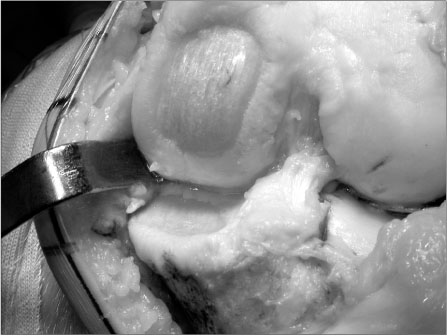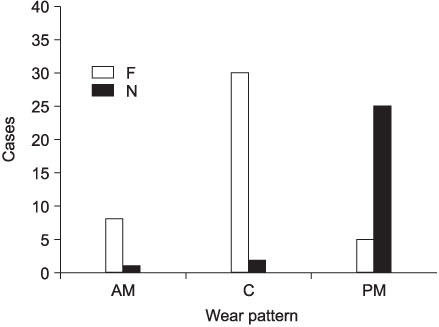J Korean Orthop Assoc.
2007 Jun;42(3):340-344. 10.4055/jkoa.2007.42.3.340.
The Wear Pattern of Articular Cartilage of Medial Tibial Plateau with or without Functional ACL in Patients with Degenerative Osteoarthritis of the Knee
- Affiliations
-
- 1Department of Orthopedic Surgery, Madi Hospital, Korea.
- 2Department of Hanyang University College of Medicine, Korea. chhchoi@hanyang.ac.kr
- 3Department of Cheil Orthopedic Hospital, Seoul, Korea.
- KMID: 2186558
- DOI: http://doi.org/10.4055/jkoa.2007.42.3.340
Abstract
-
PURPOSE: This study examined the wear pattern of the articular cartilage of the medial tibial plateau with or without a functional ACL in patients with degenerative osteoarthritis of the knee.
MATERIALS AND METHODS
Between July 2003 and May 2004, 71 cases (52 patients) of total knee arthroplasty due to degenerative osteoarthritis of the knee were enrolled in this study. The intraoperative evaluations such as a test for the functional status of the ACL and the wear pattern of medial tibial plateau were performed, and the associations with the physical examinations such as, range of motion (ROM), Lachman test and pivot shift test, and tibio-femoral angle (TFA), were analyzed.
RESULTS
There were 43 cases with a functional ACL, and the wear pattern of the medial tibial plateau was differentiated as anteromedial and central in 8 cases (18.6%), central in 30 cases (69.8%), and central and posteromedial in 5 cases (11.6%). There were 28 cases with a non- functional ACL and the wear pattern of the medial tibial plateau was differentiated as anteromedial and central in 1 case (3.6%), central in 2 cases (7.2%), and central and posteromedial in 25 cases (89.2%). In the group with the non-functional ACL, the most prevalent wear pattern was central and posteromedial (p<0.001).
CONCLUSION
In patients with degenerative osteoarthritis of the knee without a functional ACL, the wear pattern of the articular cartilage of the medial tibial plateau was more posteromedially than patients with a functional ACL.
Keyword
MeSH Terms
Figure
Reference
-
1. Ahlbäck S. Osteoarthritis of the knee. A radiographic investigation. Acta Radiol (Stockh). 1968. 277:Suppl. 7–72.2. Freeman MAR. Apley AG, editor. The pathogenesis of primary osteoarthrosis: an hypothesis. Modern trends in orthopaedics. 1972. Vol 6. London: Butterworths;40.3. Freeman MAR, Meachim G. Freeman MAR, editor. Aging and degeneration. Adult articular cartilage. 1979. 2nd ed. Tunbridge Wells: England: Pitman Medical;487.4. Harrington IJ. Static and dynamic loading patterns in knee joints with deformities. J Bone Joint Surg Am. 1983. 65:247–259.
Article5. Hernborg JS, Nilsson BE. The natural course of untreated osteoarthritis of the knee. Clin Orthop Relat Res. 1977. 123:130–137.
Article6. Hill CL, Seo GS, Gale D, Totterman S, Gale ME, Felson DT. Cruciate ligament integrity in osteoarthritis of the knee. Arthritis Rheum. 2005. 52:794–799.
Article7. Iwaki H, Pinskerova V, Freeman M. Tibiofemoral movement 1: the shapes and relative movements of the femur and tibia in the unloaded cadaver knee. J Bone Joint Surg Br. 2000. 82:1189–1195.
Article8. Morrison JB. The mechanics of the knee joint in relation to normal walking. J Biomech. 1970. 3:51–61.
Article9. Schipplein OD, Andriacchi TP. Interaction between active and passive knee stabilizers during level walking. J Orthop Res. 1991. 9:113–119.
Article10. White SH, Ludkowski PF, Goodfellow JW. Anteromedial osteoarthritis of the knee. J Bone Joint Surg Br. 1991. 73:582–586.
Article11. Zuppinger H. Die aktive flexion im unbelasteten kniegelenk. 1904. Wiesbaden: Bergmann;703.
- Full Text Links
- Actions
-
Cited
- CITED
-
- Close
- Share
- Similar articles
-
- Effect of Displacement and Morphological Change of Medial Meniscus on Early Osteoarthritis of the Knee
- Relationship between the Arthritic Changes and a Deficiency of the Anterior Cruciate Ligament in Osteoarthritic Knees
- Spontaneous Osteonecrosis of the Contralateral Medial Tibial Plateau Following Spontaneous Osteonecrosis of Medial Femoral Condyle
- Arthroscopic Abrasion Arthroplasty in Degenerative Osteoarthritis & Posttraumatic Osteoarthritis of the Knee
- An Experimental Study on Changes of Articular Cartilage following Injury of Ligaments and or Meniscus of the Knee Joint in Adult Rabbits





